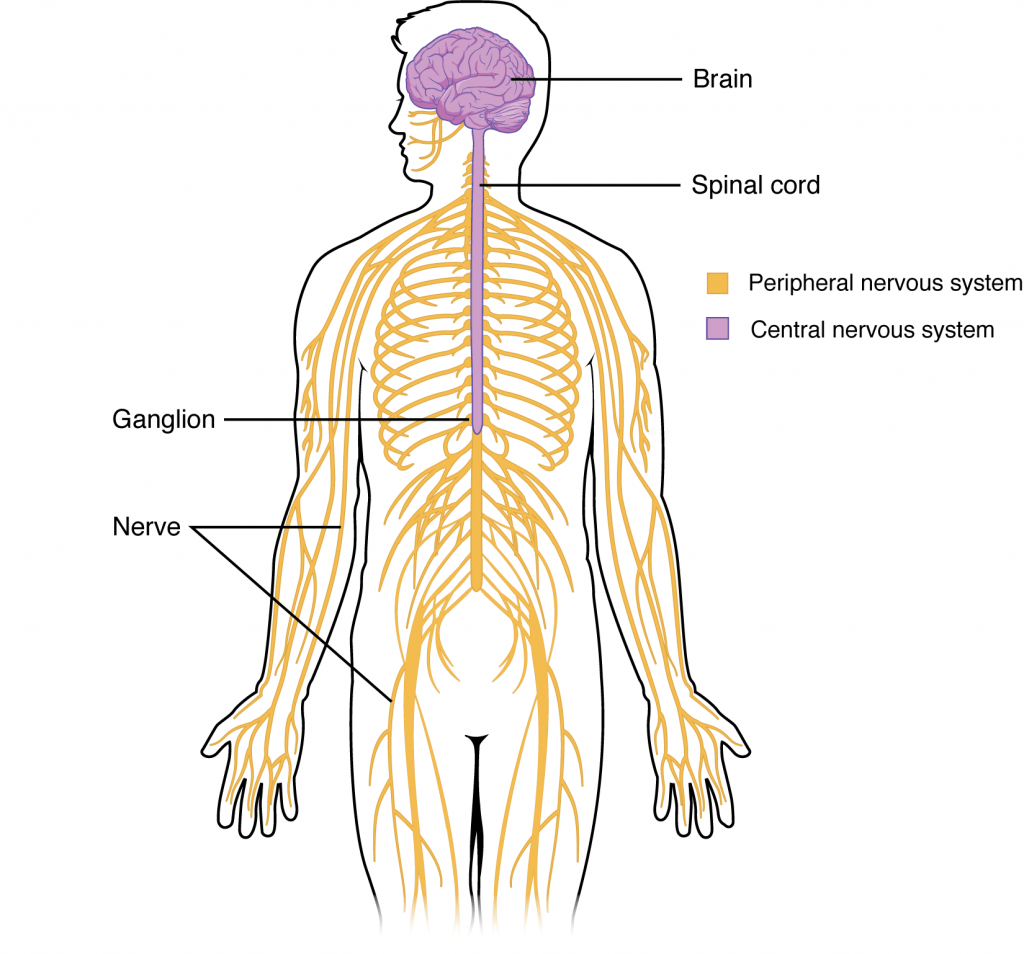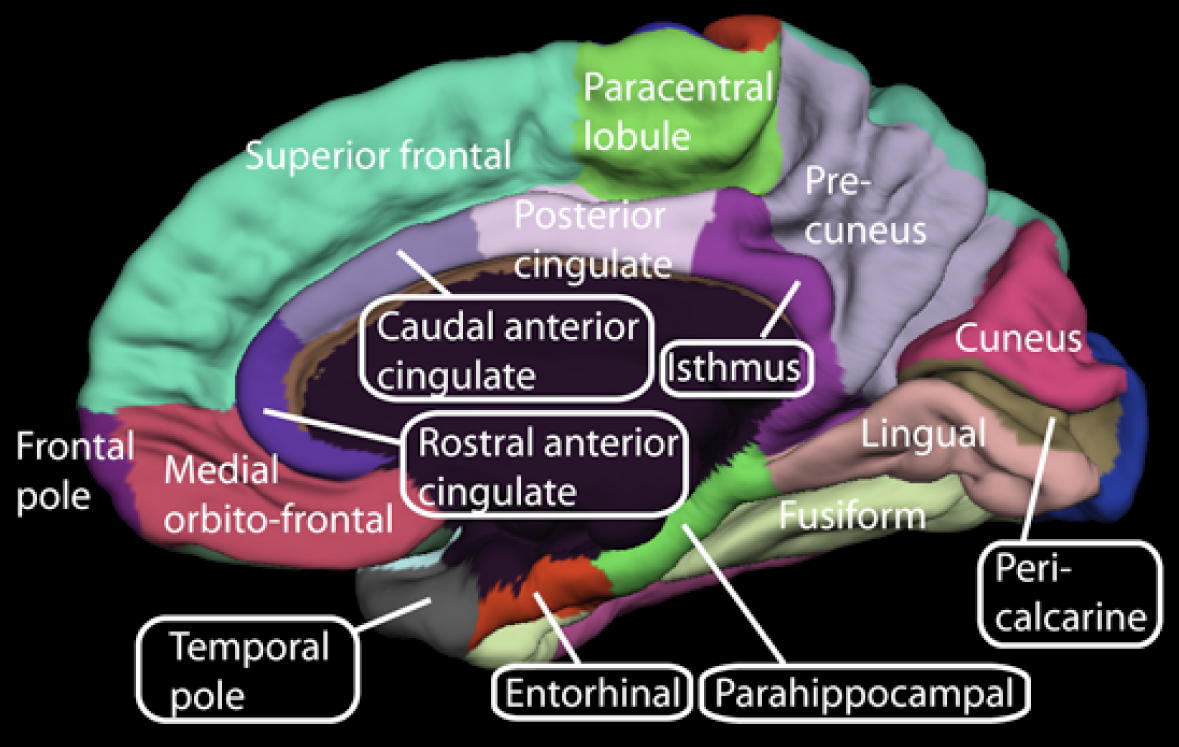The central nervous system is composed of the brain and the spinal cord. The brain consists of the cerebrum, brainstem and cerebellum. The brainstem is made of midbrain, pons and medulla.

The CNS contains the brain and spinal cord, the PNS includes nerves.
The cerebrum is made of two cerebral hemispheres that are connected by the corpus callosum. The cerebrum has grey matter which is made of neurons and white matter which is made of connecting fibers which are nothing but axons of the neurons. Each hemisphere can be divided into four lobes by deep fissures called sulci. These are frontal lobe, parietal lobe, temporal and occipital lobe. Due to rapid growth of the brain in a relatively tight and small cranial cavity, the brain tissue bulges out in between the fissures, in the form of gyri. Remember that gyri atrophy in Alzheimer’s disease, some cases of psychosis, frontotemporal or Pick’s dementia etc. The central sulcus divides the frontal lobe from the parietal lobe. The lateral sulcus (Sylvian fissure) separates the frontal and parietal lobes which are located superiorly from the temporal lobe which is located inferiorly.


The cerebrum can be divided further into the diencephalon (consisting of the thalamus, hypothalamus, epithalamus and subthalamus) and telencephalon (consisting of the cortex and basal ganglia).

It is located in the precentral gyrus in the frontal lobe, called Brodmann area 4. It is involved in the execution of simple movements of contralateral muscles.
It lies anterior to the primary motor cortex in Brodmann area 6 of the frontal lobe. It is associated with more complex movements and planning movements. It is divided into medial and lateral regions. Lateral region is involved in conditional motor tasks and in selecting movements appropriate to the context of the action. Medial region is involved in initiating movements specified by internal cues like executing motor movements from memory.
It is located on lateral and medial sides of the frontal lobe. It is involved in complex movements like performance of movements in a sequence e.g. dancing.

The cerebral cortex can be described as containing three types of processing regions: primary, association, and integration areas. The primary cortical areas are where sensory information is initially processed, or where motor commands emerge to go to the brain stem or spinal cord. Association areas are adjacent to primary areas and further process the modality-specific input. Multimodal integration areas are found where the modality-specific regions meet; they can process multiple modalities together or different modalities on the basis of similar functions, such as spatial processing in vision or somatosensation.
It is located in the postcentral gyrus of the parietal lobe, Brodmann areas 3, 1 and 2. S1 ultimately receives all sensory input from the VPL and VPM nuclei of the thalamus and processes the sensations of pain, temperature, touch, vibration, position from the contralateral body areas.
It is located in the inferior part of the parietal lobe in Brodmann area 40. It receives inputs from S1 and thalamus. It is involved in sensorimotor integration, integration of information from the two body halves, attention, learning and memory.
It is located in Brodmann areas 5 and 7 of the parietal lobe in the superior parietal lobule. They are involved in complex associations. Damage causes tactile agnosia (inability to recognize an object even though they can feel the object when it is touched).
It lies in the occipital lobe corresponding to Brodmann area 17, surrounding the calcarine sulcus. The upper parts of the world project to the lower part of the visual cortex. Macula is represented at the posterior tip of the striate cortex. The visual association areas surround the primary visual cortex. They are involved in recognition of form, color and movement.
It is located in the temporal lobe in the superior temporal gyrus, Brodmann area 41. Auditory association area is Brodmann area 42. Their function is interpretation of sound.
It is located in the inferior frontal gyrus of the frontal lobe in the dominant hemisphere. It corresponds to Brodmann area 44 and 45. Originally thought to be involved with language production, but it has recently been associated, though partly, with language comprehension as well. It is involved in language repetition, gesture production, grammar, language fluidity, interpretation of actions, understanding the meaning of words and understanding how words sound/accent. Hypoactivity in Broca’s area is seen in stammering/ stuttering.
It is located in the left, posterior-superior temporal lobe, approximately Brodamnn areas 39,40. Traditionally, it has mainly been associated with speech comprehension or understanding. Lesion in this area causes Wernicke’s aphasia also called fluent or receptive aphasia. The ability to understand the meaning of spoken words is affected but talking or language production is not impaired. Speech may thus seem a bit nonsensical.
The body is represented upside down, with the toes represented superiorly and face represented inferiorly in the cerebral cortex.

Neocortex is the most recently evolved area of the cerebral cortex. The majority of human cerebral cortex is neocortex. It is arranged in six layers, from superficial to deep as follows:
Layer I
Molecular layer. It is deficient in cells but has interconnected network of dendrites and axons called the neuropil.
Layer II
External granular layer. It is composed of inhibitory granule cells.
Layer III
External pyramidal layer. It has smaller pyramidal cells.
Layer IV
Internal granular layer. It is rich in stellate cells which receive inputs from the thalamus in the primary sensory cortex.
Layer V
Internal pyramidal layer. Larger pyramidal neurons in layers V and VI form the corticospinal and corticobulbar tracts. “Betz cell” is a large pyramidal cell that has a long dendrite at the apex that extends all the way up to layer I.
Layer VI
Multiform or fusiform layer. It forms association and projection fibers.
These cells provide support to the neurons. They are microglia, astrocytes and oligodendrocytes. Microglia are like monocytes and they are involved in phagocytosis. They are scavenger cells of the CNS. They fuse to form multinucleated giant cells in HIV.
Astrocytes are multifunctional and are involved in the formation of blood brain barrier via foot processes, lay down scar tissue after local injury, buffer extracellular K+, remove excess neurotransmitters, form external and internal glial limiting membrane, undergo hypertrophy and hyperplasia in response to injury. GFAP (glial fibrillary acidic protein) and glutamine synthetase are markers for astrocytes.
Oligodendrocytes lay down myelin in the CNS (Remember that Schawnn cells lay down myelin in the peripheral nervous system. They are injured in GBS). They have a “fried egg” appearance on histology. They are injured in multiple sclerosis, leukodystrophies and progressive multifocal leukoencephalopathy.
Ependymal cells line the ventricles of the brain. Choroid epithelial cells line the villi of the choroid plexuses and secrete CSF.
Sign up for free to take 22 quiz questions on this topic